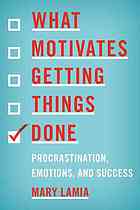
What Motivates Getting Things Done
Procrastination, Emotions, and Success
کتاب های مرتبط
- اطلاعات
- نقد و بررسی
- دیدگاه کاربران
نقد و بررسی

May 1, 2017
Interestingly enough, both procrastinators and nonprocrastinators are successful in their endeavors, though each respond to motivation in different ways. Lamia, clinical psychologist and faculty chair (Wright Inst., Berkeley, CA) has made a lifetime study of human emotions. She explains that people are moved to complete a task by not only positive but also negative emotions such as anxiety, fear of failure, and shame. Through her descriptions of personality types and motivators, readers learn to optimize their own style of action, respond to intense feelings, and be committed to meeting goals. The "troubleshooting guide" at the end of the book outlines various ways to handle life's glitches as they come along. VERDICT This motivating self-help guide will have wide appeal, but it is primarily geared toward the college-educated reader.
Copyright 2017 Library Journal, LLC Used with permission.

November 6, 2017
Clinical psychologist Lamia (Emotions! Making Sense of Your Feelings) uses this occasionally insightful but repetitive and unsurprising study to discuss the relationship between procrastination and success. She analyzes the difference between successful people who are procrastinators—“deadline-driven” people—and non-procrastinators—“task-driven” people. Emphasizing that anxiety can be a positive motivating force, Lamia writes that task-driven people complete tasks to avoid the anxiety over having one remain unfinished. Deadline-driven people, conversely, use the anxiety they feel as a deadline approaches to get a task finished. The book hammers home these points with numerous examples. The book is at its best when addressing how being labeled a procrastinator can negatively affect children and adults, and how the two work styles interact with each other. Despite a whole chapter on the subject, failure is never meaningfully addressed. Readers will find some good advice for getting along with people with different work strategies, but the central observation about deadline- and task-driven people feels too obvious to justify a full-length book.

June 1, 2017
When it comes to getting things done, according to clinical psychologist Lamia, we can be divided into two camps: task-driven and deadline-driven. The task-driven folks keep detailed lists of projects and can't really rest until everything is checked off. The deadline-driven mull over commitments before they begin and use the pressure of a deadline to complete their work. Interestingly, Lamia doesn't consider one approach to be better than the other. Although the task-driven seem to be on top of things, they can sometimes rush, producing work that isn't always their best. Despite the last-minute heroics, the deadline-driven can complete their work on time and produce high-quality results. (She does make a distinction between procrastinators who meet and don't meet their deadlines.) The trick is embracing your style and working with it. Lamia provides illuminating insights into the positive and negative emotions that shape these attributes as well as a troubleshooting guide that offers concrete suggestions on ways to successfully harness stress and clear that to-do list.(Reprinted with permission of Booklist, copyright 2017, American Library Association.)

























دیدگاه کاربران